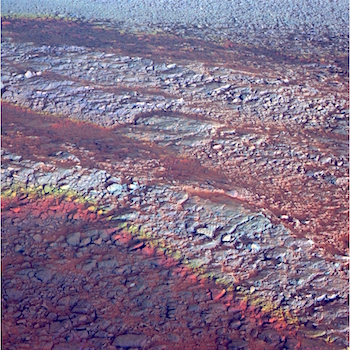 August 1, 2017: Opportunity enters Perseverance Valley, eettles in for solar conjunction: After struggling to get her left front wheel unstuck in June, Opportunity quickly adapted to a new driving strategy and unabashedly cruised into Perseverance Valley in July, making it look easy as she drove onto a small knoll to wait out solar conjunction. Then, as the routine celestial event pulled Mars behind the Sun and the veteran explorer got to work on autopilot, something unexpected happened, leaving the Mars Exploration Rovers (MER) mission with an unwanted mystery to solve as August came over the horizon.
August 1, 2017: Opportunity enters Perseverance Valley, eettles in for solar conjunction: After struggling to get her left front wheel unstuck in June, Opportunity quickly adapted to a new driving strategy and unabashedly cruised into Perseverance Valley in July, making it look easy as she drove onto a small knoll to wait out solar conjunction. Then, as the routine celestial event pulled Mars behind the Sun and the veteran explorer got to work on autopilot, something unexpected happened, leaving the Mars Exploration Rovers (MER) mission with an unwanted mystery to solve as August came over the horizon.
For years, even before Opportunity pulled up to the western rim of Endeavor Crater and Cape York in August 2011, the MER scientists had their eyes on Perseverance, a shallow valley carved into the rim farther south at Cape Byron. It’s as unique a geologic site as they’ve seen on the entire mission, and it hints of the past water and habitable environments they had come to Meridiani Planum to find. (…)
“Perseverance has been calling us for years,” said MER Principal Investigator Steve Squyres, of Cornell University. “Exploring the valley is the next big science phase of the mission. This is just tremendously exciting.”
About 20 meters (21.87 yards) wide, the valley stretches downslope from the rim some 180 meters (196.85-yards) to the floor of Endeavor Crater, which dates back the Noachian Period 3 to 4 billions of years ago when Mars was warmer and wetter and, scientists generally believe, more like Earth. Since Opportunity is the only robot to have ever explored the rocky remnants of this ancient Martian time, Perseverance is a big exploratory deal.
Although Opportunity uncovered evidence for water and clays and past habitable environments at Cape York on Matijevic Hill, Perseverance could turn out to be the most telling site the rover and her Earth-bound colleagues will visit. “The work we do here will be the first ground-based exploration of a preserved valley system on Mars,” said MER Deputy Principal Investigator Ray Arvidson, of Washington University St. Louis… [More at link]








